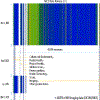Meaningful associations in the adolescent brain cognitive development study
- PMID: 34147629
- PMCID: PMC8803401
- DOI: 10.1016/j.neuroimage.2021.118262
Meaningful associations in the adolescent brain cognitive development study
Abstract
The Adolescent Brain Cognitive Development (ABCD) Study is the largest single-cohort prospective longitudinal study of neurodevelopment and children's health in the United States. A cohort of n = 11,880 children aged 9-10 years (and their parents/guardians) were recruited across 22 sites and are being followed with in-person visits on an annual basis for at least 10 years. The study approximates the US population on several key sociodemographic variables, including sex, race, ethnicity, household income, and parental education. Data collected include assessments of health, mental health, substance use, culture and environment and neurocognition, as well as geocoded exposures, structural and functional magnetic resonance imaging (MRI), and whole-genome genotyping. Here, we describe the ABCD Study aims and design, as well as issues surrounding estimation of meaningful associations using its data, including population inferences, hypothesis testing, power and precision, control of covariates, interpretation of associations, and recommended best practices for reproducible research, analytical procedures and reporting of results.
Keywords: Adolescent brain cognitive development study; Covariate Adjustments; Effect Sizes; Genetics; Hypothesis testing; Population neuroscience; Reproducibility.
Copyright © 2021 The Author(s). Published by Elsevier Inc. All rights reserved.
Figures






References
-
- Bachman JG, Johnston LD, O’Malley PM & Schulenberg JE The monitoring the future project after thirty-seven years: Design and procedures. (2011).
-
- Chantala K & Tabor J National longitudinal study of adolescent health. Strategies to perform a design-based analysis using the add health data (1999).
-
- Conway KP, Swendsen J, Husky MM, He J-P & Merikangas KR Association of lifetime mental disorders and subsequent alcohol and illicit drug use: Results from the national comorbidity survey–adolescent supplement. Journal of the American Academy of Child & Adolescent Psychiatry 55, 280–288 (2016). - PubMed
-
- Ingels S, Abraham S, Karr R, Spenser B & Frankel M National education longitudinal survey of 1988. Technical Report. National Opinion Research Center, University of Chicago; (1990).
Publication types
MeSH terms
Grants and funding
- U24 DA041147/DA/NIDA NIH HHS/United States
- U01 DA051039/DA/NIDA NIH HHS/United States
- U01 DA041120/DA/NIDA NIH HHS/United States
- U01 DA051018/DA/NIDA NIH HHS/United States
- U01 DA041093/DA/NIDA NIH HHS/United States
- U24 DA041123/DA/NIDA NIH HHS/United States
- U01 DA051038/DA/NIDA NIH HHS/United States
- U01 DA051037/DA/NIDA NIH HHS/United States
- U01 DA051016/DA/NIDA NIH HHS/United States
- U01 DA041106/DA/NIDA NIH HHS/United States
- U01 DA041117/DA/NIDA NIH HHS/United States
- U01 DA041148/DA/NIDA NIH HHS/United States
- P50 HD103525/HD/NICHD NIH HHS/United States
- U01 DA041174/DA/NIDA NIH HHS/United States
- U01 DA041134/DA/NIDA NIH HHS/United States
- U01 DA041022/DA/NIDA NIH HHS/United States
- U01 DA041156/DA/NIDA NIH HHS/United States
- U01 DA050987/DA/NIDA NIH HHS/United States
- U01 DA041025/DA/NIDA NIH HHS/United States
- U01 DA050989/DA/NIDA NIH HHS/United States
- U01 DA041089/DA/NIDA NIH HHS/United States
- U01 DA050988/DA/NIDA NIH HHS/United States
- U01 DA041028/DA/NIDA NIH HHS/United States
- U01 DA041048/DA/NIDA NIH HHS/United States

